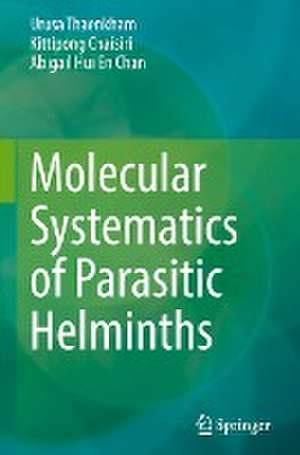Molecular Systematics of Parasitic Helminths
Autor Urusa Thaenkham, Kittipong Chaisiri, Abigail Hui En Chanen Limba Engleză Hardback – 26 mai 2022
The book will benefit postgraduate students and researchers requiring the detailed knowledge of molecular systematics,as well as researchers desiring a guideline to select genetic markers and analyze DNA sequences to make phylogenetic inferences
| Toate formatele și edițiile | Preț | Express |
|---|---|---|
| Paperback (1) | 893.70 lei 38-44 zile | |
| Springer Nature Singapore – 27 mai 2023 | 893.70 lei 38-44 zile | |
| Hardback (1) | 895.23 lei 38-44 zile | |
| Springer Nature Singapore – 26 mai 2022 | 895.23 lei 38-44 zile |
Preț: 895.23 lei
Preț vechi: 1177.93 lei
-24% Nou
Puncte Express: 1343
Preț estimativ în valută:
171.30€ • 179.33$ • 141.74£
171.30€ • 179.33$ • 141.74£
Carte tipărită la comandă
Livrare economică 01-07 aprilie
Preluare comenzi: 021 569.72.76
Specificații
ISBN-13: 9789811917851
ISBN-10: 981191785X
Pagini: 396
Ilustrații: XIX, 396 p. 1 illus.
Dimensiuni: 155 x 235 mm
Greutate: 0.59 kg
Ediția:1st ed. 2022
Editura: Springer Nature Singapore
Colecția Springer
Locul publicării:Singapore, Singapore
ISBN-10: 981191785X
Pagini: 396
Ilustrații: XIX, 396 p. 1 illus.
Dimensiuni: 155 x 235 mm
Greutate: 0.59 kg
Ediția:1st ed. 2022
Editura: Springer Nature Singapore
Colecția Springer
Locul publicării:Singapore, Singapore
Cuprins
Chapter 1: Concept of molecular systematics.- Chapter 2: Parasitic helminths of medical and veterinary importance.- Chapter 3: Overview of parasitic helminth diversity: how molecular systematics is involved .- Chapter 4: Molecular evolution of parasitic helminths.- Chapter 5: Challenges of species delimitation for parasitic helminths.- Chapter 6: Molecular genetic markers: general use in parasitic helminth researches .- Chapter 7: PCR and DNA sequencing: guidelines for PCR, primer design, and sequencing for molecular systematics and identification.- Chapter 8: DNA sequence alignment and phylogenetic inferences: guidelines for analysis and the selection of appropriate methods for molecular systematics.- Chapter 9: Parasitic helminth sample preparation for taxonomic study.- Chapter 10: Molecular systematics of nematodes.- Chapter 11: Molecular systematics of trematodes.- Chapter 12: Molecular systematics of cestodes.- Chapter 13: DNA taxonomy of parasitic helminths.- Chapter 14: Implementation of genetic markers from molecular systematics to DNA taxonomy and field applications.- Chapter 15: Concluding remarks and further prospective.
Notă biografică
Urusa Thaenkham (Ph.D. in Tropical Medicine from Mahidol University, Thailand) is an expert in molecular systematics, population genetics, molecular identification, and molecular diagnosis of parasitic helminths, particularly foodborne parasites. The current research interest is the development of DNA barcoding and metabarcoding of parasitic helminths.
Kittipong Chaisiri (Ph.D. in Infection and Global Health from the University of Liverpool, UK) is an expert in rodent-borne diseases, helminth systematic and taxonomy, parasite diversity and ecology, and microbiome analysis. Current research interest is in ecological health, “One health” and “Planetary heath” research themes focusing on the influence of biodiversity..
Abigail Hui En Chan (MSc in Tropical Medicine from Mahidol University, Thailand) is a PhD candidate at the Faculty of Tropical Medicine, Mahidol University. Current research interest is in molecular systematics, DNA barcoding, and metabarcoding of parasitic helminths.
Textul de pe ultima copertă
This book aims to provide fundamental knowledge and information for research in molecular systematics on parasitic helminths (nematode, trematode, cestode). The shreds of evidence of molecular systematics studies will be compiled and discussed in terms of the utilities and pitfalls of the genetic marker used for various purposes, which have been implemented for molecular systematics of parasitic nematodes, cestodes, and trematodes. Moreover, this book will also provide the procedure for research on molecular systematics and DNA taxonomy as the guideline to explore parasitic helminths. Finally, the further perspectives of utilizing genetic markers for molecular studies on parasitic helminths will be addressed in the context of applications from the laboratory to fieldwork such as DNA barcoding and environmental DNA metabarcoding of parasitic helminths.
The book will benefit postgraduate students and researchers requiring the detailed knowledge of molecular systematics, as well as researchers desiring a guideline to select genetic markers and analyze DNA sequences to make phylogenetic inferences
The book will benefit postgraduate students and researchers requiring the detailed knowledge of molecular systematics, as well as researchers desiring a guideline to select genetic markers and analyze DNA sequences to make phylogenetic inferences
Caracteristici
Describes essential concepts of molecular systematics and the utilities of genetic markers for parasitic helminths Introduces the fundamental analyzes using DNA sequences for phylogenetic inferences Provides guidelines for sample preparation and DNA taxonomy management
